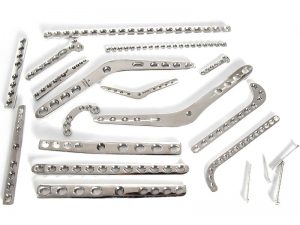
Veterinary orthopedic implants are medical devices that are specifically designed and manufactured for use in animals to treat orthopedic conditions or injuries. These implants are made from high-quality materials that are biocompatible and can withstand the stresses and strains of animal movement.
Some common veterinary orthopedic implants include plates, screws, pins, wires, and external fixators, which can be used to stabilize fractures, repair ligament and tendon injuries, and treat joint instability or other musculoskeletal conditions. The implants are typically made from materials such as stainless steel, titanium, or composite materials, which provide strength and durability while minimizing the risk of complications or adverse reactions.
Orthopedic surgery in animals has become increasingly sophisticated in recent years, and the use of veterinary orthopedic implants has become more common as a result. Advances in imaging and surgical techniques have also made it possible to treat a wider range of orthopedic conditions in animals, which can help to improve their quality of life and reduce the risk of long-term complications. Veterinary orthopedic implants play a critical role in these treatments, providing the necessary support and stability for the affected limb or joint while the body heals and recovers.
There are many different types of orthopedic implants, which are used to treat a wide range of conditions related to the musculoskeletal system. Here are some of the most common types of orthopedic implants:
- Plates: These are metal plates that are screwed onto the surface of bones to provide stability and support, particularly in the treatment of fractures.
- Screws: Screws are used to attach plates to bones or to hold bones together directly. They come in various sizes and shapes, and can be made of different materials.
- Nails and Rods: Nails and rods are used to stabilize bones that have been fractured in a way that cannot be repaired with plates or screws. These implants are inserted into the bone and are often used in long bones, such as the femur or tibia.
- Pins and Wires: These are thin, metal rods or wires that are inserted through the skin and into the bone to hold a fracture in place or to provide support to a joint.
- Joints: Joint implants are used to replace damaged or diseased joints, such as the hip or knee, with a prosthesis made of metal, plastic, or ceramic materials.
- Spinal Implants: These implants are used to treat conditions related to the spine, including spinal fractures, herniated discs, and scoliosis. They can include screws, rods, plates, and intervertebral discs.
- External Fixators: These are devices that are attached to the outside of the body and used to stabilize fractures or correct deformities. They can be used in conjunction with other implants, or on their own.
The specific type of implant used depends on the individual patient’s needs and the nature of their condition. Orthopedic surgeons and other healthcare professionals are trained to select the appropriate implant based on the patient’s unique situation.
Orthopedic implants can be made from a variety of materials, depending on the specific type of implant and the needs of the patient. Some of the most common materials used in orthopedic implants include:
- Metals: Metals such as stainless steel, titanium, and cobalt-chromium alloys are commonly used in orthopedic implants because they are strong, durable, and can withstand the stresses and strains of the human body.
- Polymers: Polymers such as high-density polyethylene and ultra-high-molecular-weight polyethylene are often used in joint replacement implants because they are lightweight and can be molded into various shapes.
- Ceramics: Ceramic materials, such as alumina and zirconia, are used in orthopedic implants because they are biocompatible, wear-resistant, and can withstand high temperatures.
- Composites: Composites, such as carbon fiber reinforced polymer (CFRP), are used in some orthopedic implants because they are strong, lightweight, and can be customized for individual patients.
The choice of material for an orthopedic implant depends on many factors, including the type of implant, the location of the implant, and the patient’s medical history. In addition, there are certain properties that are important for all orthopedic implant materials, such as biocompatibility (the ability of the material to interact with the body without causing harm) and durability (the ability of the material to withstand the stresses and strains of the human body over time).
Orthopedic implants play a crucial role in the treatment of many conditions related to the musculoskeletal system, such as fractures, joint injuries, and degenerative diseases like arthritis. Here are some of the key importance of orthopedic implants:
- Improved Mobility: Orthopedic implants can help to restore mobility and improve quality of life for people with injuries or diseases that affect their bones or joints. For example, a hip replacement implant can help to alleviate the pain and stiffness caused by arthritis, allowing the patient to walk and move more easily.
- Enhanced Healing: Orthopedic implants can also aid in the healing process for patients with bone fractures or other injuries. By providing stability and support to the affected area, implants can help the bone to heal more quickly and reduce the risk of complications.
- Customized Treatment: There are a wide variety of orthopedic implants available, which can be customized to the specific needs of individual patients. This means that healthcare professionals can select the implant that is best suited for each patient’s unique situation, leading to better outcomes and faster recovery times.
- Long-lasting Results: Many orthopedic implants are designed to last for years or even decades, providing long-lasting relief and improved mobility for patients. This means that patients can return to their normal activities and maintain a high quality of life for many years after their surgery.
In short, orthopedic implants are important tools in the treatment of musculoskeletal conditions, allowing patients to recover more quickly, move more easily, and enjoy an improved quality of life.

